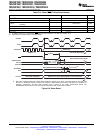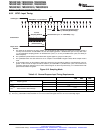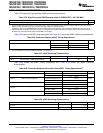
t
w(WAKE-INT)
t
d(WAKE-STBY)
t
d(IDLE−XCOL)
Wake−up
Signal
X1/X2 or
X1 or
XCLKIN
XCLKOUT
STANDBY Normal ExecutionSTANDBY
Flushing Pipeline
(A)
(B)
(C)
(D)
(E)
(F)
Device
Status
TMS320F2809, TMS320F2808, TMS320F2806
TMS320F2802, TMS320F2801, TMS320C2802
TMS320C2801, TMS320F28016, TMS320F28015
www.ti.com
SPRS230L–OCTOBER 2003–REVISED DECEMBER 2009
Table 6-18. STANDBY Mode Timing Requirements
TEST CONDITIONS MIN NOM MAX UNIT
Without input qualification 3t
c(OSCCLK)
Pulse duration, external
t
w(WAKE-INT)
cycles
wake-up signal
With input qualification
(1)
(2 + QUALSTDBY) * t
c(OSCCLK)
(1) QUALSTDBY is a 6-bit field in the LPMCR0 register.
Table 6-19. STANDBY Mode Switching Characteristics
PARAMETER TEST CONDITIONS MIN TYP MAX UNIT
Delay time, IDLE instruction
t
d(IDLE-XCOL)
32t
c(SCO)
45t
c(SCO)
cycles
executed to XCLKOUT low
Delay time, external wake signal
to program execution resume
(1)
Without input qualifier 100t
c(SCO)
• Wake up from flash
cycles
– Flash module in active
With input qualifier 100t
c(SCO)
+ t
w(WAKE-INT)
state
t
d(WAKE-STBY)
Without input qualifier 1125t
c(SCO)
• Wake up from flash
cycles
– Flash module in sleep
With input qualifier 1125t
c(SCO)
+ t
w(WAKE-INT)
state
Without input qualifier 100t
c(SCO)
cycles
• Wake up from SARAM
With input qualifier 100t
c(SCO)
+ t
w(WAKE-INT)
(1) This is the time taken to begin execution of the instruction that immediately follows the IDLE instruction. execution of an ISR (triggered
by the wake up signal) involves additional latency.
A. IDLE instruction is executed to put the device into STANDBY mode.
B. The PLL block responds to the STANDBY signal. SYSCLKOUT is held for approximately 32 cycles (if CLKINDIV = 0)
or 64 cycles (if CLKINDIV = 1) before being turned off. This delay enables the CPU pipe and any other pending
operations to flush properly.
C. Clock to the peripherals are turned off. However, the PLL and watchdog are not shut down. The device is now in
STANDBY mode.
D. The external wake-up signal is driven active.
E. After a latency period, the STANDBY mode is exited.
F. Normal execution resumes. The device will respond to the interrupt (if enabled).
Figure 6-15. STANDBY Entry and Exit Timing Diagram
Copyright © 2003–2009, Texas Instruments Incorporated Electrical Specifications 113
Submit Documentation Feedback
Product Folder Link(s): TMS320F2809 TMS320F2808 TMS320F2806 TMS320F2802 TMS320F2801 TMS320C2802
TMS320C2801 TMS320F28016 TMS320F28015


















